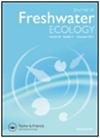Increased juvenile native fish abundance following a major flood in an Arizona river
IF 1.3
4区 环境科学与生态学
Q3 ECOLOGY
引用次数: 1
Abstract
Abstract Spring floods trigger spawning in many native fishes of the desert Southwest (USA), but less is known about fish community response when native fishes are rare. Here, we document change to native and nonnative fish captures and instream habitat features following a decade-high flooding event (2019) in the Verde River (AZ) where native fish captures were rare in the years pre-flood. Using prepositioned areal electrofishing devices (PAEDs), we sampled the fish community at 90 sampling units pre-flood (2017) and resampled those same units post-flood (2019) to compare and identify changes to catch and habitat features. Relative abundance of native fishes increased from 0.6% pre-flood (0.01 fish/PAED) to 53.0% post-flood (1.66 fish/PAED) and was largely attributable to the presence of juvenile Roundtail Chub Gila robusta (≤ 70 mm total length (TL)) and juvenile Sonora Sucker Catostomus insignis (≤ 100 mm TL). Juvenile Desert Sucker Catostomus clarkii experienced a lesser increase. One adult native fish was captured in 2017 and adult native fishes were absent from 2019 sampling. The catch of adult/subadult Common Carp Cyprinus carpio (> 100 mm TL) declined; however, this could be related to reservoir management and not the flood. The abundance of all size-classes of Black Bass Micropterus spp., Red Shiner Cyprinella lutrensis and other nonnative fishes did not change. The majority (97%) of juvenile native fishes were captured at the uppermost sampling reach. A 54% reduction to canopy cover across all sampling reaches and an increase of fine sediments at the most downstream reach demonstrates how floods can restructure the river environment. This case-study adds evidence that protection of spring floods is vital to the persistence and recolonization of fishes native to the desert Southwest, especially where they are rare. The continued presence of nonnative species may preclude juvenile native fishes from recruiting to adults.亚利桑那州一条河流发生大洪水后,本地幼鱼数量增加
摘要春季洪水引发了美国西南部沙漠地区许多本地鱼类的产卵,但当本地鱼类稀少时,人们对鱼类群落的反应知之甚少。在这里,我们记录了在Verde河(AZ)发生十年一遇的洪水事件(2019年)后,本地和非本地鱼类捕获和河流内栖息地特征的变化,在洪水发生前的几年里,本地鱼类捕获很少。使用预先放置的区域电捕鱼设备(PAED),我们在洪水前(2017年)以90个采样单位对鱼类群落进行了采样,并在洪水后(2019年)对这些相同的单位进行了重新采样,以比较和识别捕获物和栖息地特征的变化。本地鱼类的相对丰度从洪水前的0.6%(0.01条鱼/PAED)增加到洪水后的53.0%(1.66条鱼/PAED),这在很大程度上归因于幼年圆尾Chub Gila robusta(≤70 总长度(TL)mm)和幼年Sonora Sucker Catostomus徽章(≤100 mm TL)。幼年沙漠吸盘克氏Catostomus clarkii的增长幅度较小。2017年捕获了一条成年本地鱼类,2019年的采样中没有成年本地鱼类。成年/亚成年鲤鱼的捕获量(>100) mm TL)下降;然而,这可能与水库管理有关,而不是与洪水有关。黑鲈鱼、红鲷和其他非本地鱼类的丰度没有变化。大多数(97%)本地幼鱼是在最上层采样河段捕获的。所有采样河段的树冠覆盖率降低了54%,最下游河段的细沉积物增加,这表明洪水可以重组河流环境。这项案例研究补充了证据,证明保护春季洪水对西南沙漠鱼类的生存和重新定居至关重要,尤其是在它们稀少的地方。非本地物种的持续存在可能会阻碍幼年本地鱼类向成年鱼类招募。
本文章由计算机程序翻译,如有差异,请以英文原文为准。
求助全文
约1分钟内获得全文
求助全文
来源期刊
CiteScore
2.20
自引率
7.70%
发文量
34
审稿时长
3 months
期刊介绍:
The Journal of Freshwater Ecology, published since 1981, is an open access peer-reviewed journal for the field of aquatic ecology of freshwater systems that is aimed at an international audience of researchers and professionals. Its coverage reflects the wide diversity of ecological subdisciplines and topics, including but not limited to physiological, population, community, and ecosystem ecology as well as biogeochemistry and ecohydrology of all types of freshwater systems including lentic, lotic, hyporheic and wetland systems. Studies that improve our understanding of anthropogenic impacts and changes to freshwater systems are also appropriate.

 求助内容:
求助内容: 应助结果提醒方式:
应助结果提醒方式:


